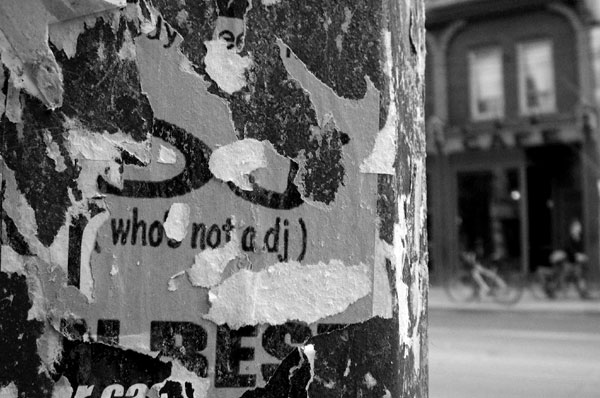|
The poster's potential Plastering posters to poles, walls, and mailboxes is a great and inexpensive way to advertise political rallies, music concerts, and garage sales. But postering’s potential goes far beyond that of promotion. If magazines, books, and newspapers were 100% ads, most people probably wouldn’t be too interested in them. So it’s a good thing that these publications are more than ads — they also usually carry some insightful, thought provoking, and moving writing, information and art. There is no reason why postering should be any different. Although the majority of posters are used for advertising, not all are. Some graffiti artists complement their work by pasting up photocopied and silk-screened visual art. And many Torontonians likely remember the large posters displaying a portrait of a young woman entitled ‘Jane’ that were plastered throughout our city. Many posters carrying political messages don’t advertise organizations, protests or meetings but rather comment on the issues themselves. Some anti-war posters, for example, have shown pictures of Iraqi children playing and then listed items that were banned in the embargo on Iraq, while others have shown pictures of casualties of war. But while posters displaying visual art and political messages go beyond advertising, they demonstrate only the beginning of postering’s other possibilities. I first came across the idea of using posters in a broader way from a book called Bomb the Suburbs. The author, William Upski Wimsatt, had been involved in making a hip-hop publication called Subway and Elevated. They distributed it by taping it up along the train lines where it could be reached by transit users. Each issue was a broadsheet with two sides. One side, called subway, covered stories that were not being told in mainstream media, while the other, called elevated, tried to generate strategies and solutions to deal with problems that get raised by the mainstream media. Although Subway and Elevated was available to all transit users, it was geared to ghetto youth. By being a publication that spoke to them, they hoped to get people reading who otherwise might not. Subway and Elevated was also used as a way to revive public places, since only those who ventured into the public domain had access to it. As Upski Wimsatt writes in his second book No More Prisons “if you drove a car, lived in the suburbs, and sent your kids to private school then for once in your life you couldn’t have one.” I thought the idea of posting a publication was brilliant. Postering is a fun, inexpensive, and relatively easy way to reach people living in your community as well as those who are just passing by. This is one of the advantages of postering: it reaches people out on the street. While information in a book or on a website is available only to those who go to the trouble to seek it or stumble upon it while looking for something else, posters have the ability to unexpectedly catch the eyes of anyone walking by. Posters can change the way people interact with the city. Quality posters can be a destination themselves, instead of just something you pass on your way somewhere else. Since they are stationary, posters also have the ability to comment on the area in which they are posted, thereby affecting the way people view that particular spot. And while many other mediums are used in isolation, posters communicate publicly, on the street, where people have the option of sharing their reaction with others. Posters can also be interactive. When the pope came to Toronto, someone put up a giant sign that read simply: “What do you think about the pope’s visit?” They left a marker hanging on the sign, and it soon filled with an array of opinions. By putting up a poster with space for feedback, anyone with a marker can add their comments. A dialogue can be created, with conversations going back and forth the way they do on bathroom stalls. Overall, postering is a dynamic way of communicating to others and offers many advantages compared to other media. So why not consider posting up articles, rants, commentaries, poetry and art? Imagine a back alley renowned for its haiku, an art show pasted to an abandoned building, or a giant comic attached to a long wall. If you’re inspired to say something with posters, there is nothing stopping you. Post it up. Tim Groves is responsible for The Missing Plaque Project |
|
spacing.ca || contact || subscribe || in this issue || stores (c) 2004 Spacing Publishing |

